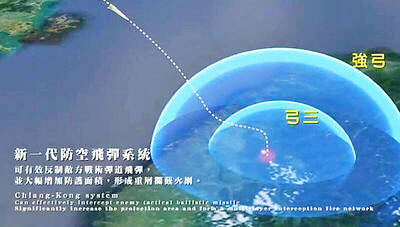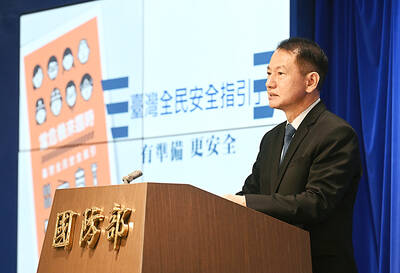Tens of thousands of Hong Kongers yesterday marched through the center of Hong Kong Island to the vicinity of government headquarters, ignoring a police-approved end point and defying a ruling that shortened the planned route.
The march marked the sixth straight week of anti-government rallies that have put increasing pressure on the Hong Kong government.
The organizer, the Civil Human Rights Front said that the rallies, which have drawn hundreds of thousands of people, were held to show support for demands including the withdrawal of legislation that would allow extraditions to China, amnesty for arrested protesters and the resignation of Hong Kong Chief Executive Carrie Lam (林鄭月娥), who is backed by Beijing.

Photo: AP
The Appeal Board on Public Meetings and Processions on Saturday ruled that the march, originally planned to end at the Court of Final Appeal in Central, must finish in the Wan Chai district, citing potential difficulties in crowd control.
However, marchers ignored the ruling, and police retreated and shifted their barricades to allow the mass of protesters past the Wan Chai end point.
Shopkeepers along the route supplied marchers with water and other drinks as the temperature in the territory hovered above 30°C.
Barricades surrounding the police station in Wan Chai were converted into so-called “Lennon Walls,” spontaneous message boards adorned with brightly colored sticky labels.
Pro-democracy lawmaker Claudia Mo (毛孟靜) said that protesters wanted Lam to pledge not to target people who took part in the rallies.
“We would like her to say that there will be no prosecution of the protesters arrested, that there will be general amnesty in this very sad saga,” Mo said.
“She refuses in the name of the rule of law,” she said.
Lam will not resign and will not make any further concessions to the protesters, Hong Kong Executive Council Convener Bernard Chan (陳智思) said in an interview with the New York Times published on Friday.
The chief executive would consult with different sectors of the Hong Kong population and would concentrate on drafting a broad policy address for the middle of October, the report quoted Chan as saying.
Kingston Cheung, a 17-year-old student who has taken part in the protests since they started on June 9, said he marched yesterday to voice opposition to the government’s handling of previous protests.
“The focus of the protests has been about the extradition bill, but we are also starting to see how the government and police have mishandled them,” he said. “The abuse of power by the police has added to the public’s anger.”

LIMITS: While China increases military pressure on Taiwan and expands its use of cognitive warfare, it is unwilling to target tech supply chains, the report said US and Taiwan military officials have warned that the Chinese People’s Liberation Army (PLA) could implement a blockade within “a matter of hours” and need only “minimal conversion time” prior to an attack on Taiwan, a report released on Tuesday by the US Senate’s China Economic and Security Review Commission said. “While there is no indication that China is planning an imminent attack, the United States and its allies and partners can no longer assume that a Taiwan contingency is a distant possibility for which they would have ample time to prepare,” it said. The commission made the comments in its annual

DETERMINATION: Beijing’s actions toward Tokyo have drawn international attention, but would likely bolster regional coordination and defense networks, the report said Japanese Prime Minister Sanae Takaichi’s administration is likely to prioritize security reforms and deterrence in the face of recent “hybrid” threats from China, the National Security Bureau (NSB) said. The bureau made the assessment in a written report to the Legislative Yuan ahead of an oral report and questions-and-answers session at the legislature’s Foreign Affairs and National Defense Committee tomorrow. The key points of Japan’s security reforms would be to reinforce security cooperation with the US, including enhancing defense deployment in the first island chain, pushing forward the integrated command and operations of the Japan Self-Defense Forces and US Forces Japan, as

INTERCEPTION: The 30km test ceiling shows that the CSIST is capable of producing missiles that could stop inbound missiles as they re-enter the atmosphere Recent missile tests by the Chungshan Institute of Science and Technology (CSIST) show that Taiwan’s missiles are capable of intercepting ballistic missiles as they re-enter the atmosphere and pose a significant deterrent to Chinese missile threats, former Hsiung Feng III missile development project chief engineer Chang Cheng (張誠) said yesterday. The military-affiliated institute has been conducting missile tests, believed to be related to Project Chiang Kung (強弓) at Pingtung County’s Jiupeng Military Base, with many tests deviating from past practices of setting restriction zones at “unlimited” and instead clearly stating a 30.48km range, Chang said. “Unlimited” restrictions zones for missile tests is

PUBLIC SAFETY: The nationwide distribution campaign aims to enhance society’s overall understanding of threats and bolster defense awareness, an official said The latest edition of the National Public Safety Guide is being mailed to all citizens starting today to foster public awareness of self-defense in the event of war or natural disasters, the Ministry of National Defense said yesterday. “The guides will be disseminated to the public to enhance society’s overall understanding of threats and bolster defense awareness, demonstrating the government’s emphasis on people’s safety and its determination to pursue self-defense,” All-out Defense Mobilization Agency Director Shen Wei-chih (沈威志) said at the ministry’s news conference. The nationwide distribution campaign was planned according to President Lai William’s (賴清德) Sept. 20 directive, he said, adding